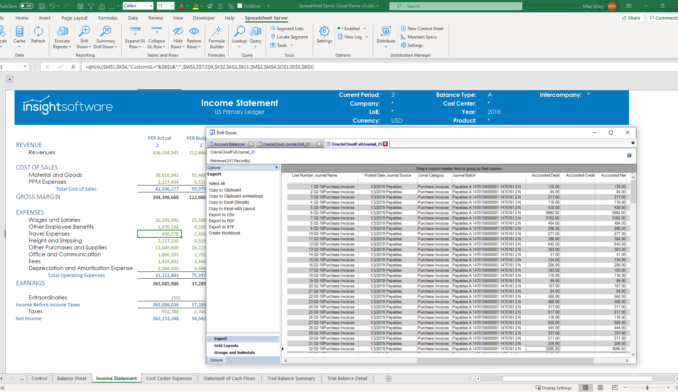Top 3 Ways to End the Spread of Year-End Close Panic Attacks

Does it take you 20 days, 30 days, or even longer to complete your year-end close? Are you struggling with consolidations for multiple subsidiaries that each run different financial management systems? Do you struggle to run financial reports in a timely fashion because you’re not confident in the integrity of your data? If so, your year-end financial close is bound to be incredibly stressful.
What if your end-of-year close could happen in one or two days instead of in a month? What if next year’s budgets and forecasts were already seeded with valid data, and you didn’t have to start from scratch? A better year-end close could mean time and money saved on audit prep, and higher confidence in the data you deliver. Most importantly, instead of answering to business units by running reports and validating data, you can become a strategic adviser telling business teams which efforts can deliver the greatest ROI.
It’s time to eliminate that backlog of journal entries that you know you haven’t posted and are putting off until year’s end. It’s time to stop reversing entries because your accounts don’t reconcile and you don’t have time to figure out why. It’s also time to get answers about unexplained variances rather than letting them keep you awake at night.
Imagine a year-end close that’s painless instead of panicked. It doesn’t have to be a dream, it’s within your reach.
Year-End Panic Triggers
Everyone’s year-end close experience is different, but there are some common threads in the journey to sleepless nights, elevated blood pressure, and caffeine overload. See if any of these sound familiar:
- Overwhelming reporting demands. Reports take too long to run, or you have to take multiple steps—extracting data from your ERP and dumping it into Excel—to create the reports people want. Every stakeholder, from creditor to investor to auditor to employee, wants answers when they want them, but you can’t deliver because you’re not confident in the accuracy of your data.
- Too many sources of data. Data can live in your ERP, in Excel spreadsheets on individual desktops, and in subsystems that have yet to be reconciled. You may not know whether all purchase orders have been reconciled to accounts payable or whether invoices in your CRM system have been recorded as accounts receivable. Plus, if your company has multiple subsidiaries, they may all use different accounting and financial management systems.
- Not enough trained staff. When you use many tools, people need to know how to use all of them during the reconciliation process. You may have one person who’s an expert on one system and another who knows another system inside and out, but not everyone has the skills they need to use every system, and there’s not enough in the training budget to make up for the shortfall.
- Discrepancies between teams. You’ve shown up at meetings with spreadsheets in which you had a number for a specific account or journal entry only to discover that others had different numbers for the same thing. Figuring out reconciliations, budgets, forecasts, and variances without a single source of truth adds risk and inefficiency to your closing process.
In addition to these worries, you have to deal with an endless series of tasks, from completing inventory counts to writing off bad debt. With pressures like these, it’s no wonder you keep a stash of antacids in your desk drawer. It’s time to figure out how to stop the stress and panic attacks in their tracks.
Creating a Better Close
When it comes to running your year-end close, you’ve probably been using one or more of these three main options:
- Working within your ERP software’s sub-par built in reporting tool
- Using a business intelligence (BI) solution
- Extracting static data manually and dumping it into Excel
These strategies often lead to low confidence in your year-end financial reporting, and high levels of frustration. ERP solutions are designed for capturing and recording transactions, and they don’t offer comprehensive reporting tools. The extract, transform, and load (ETL) process that prepares ERP data for BI software analysis risks introducing errors and is often difficult to validate; it’s also typically a process that can only be executed by people in IT, which shackles your timeframe to their availability.
And Excel, the most commonly used tool to create year-end close reports, is not designed to serve as a database. Producing Excel reports requires building and rebuilding reports, tracking down errors, and explaining variations in numbers. Too often, people input the same data and produce final static reports with differing numbers. When you store data in an ERP and do reporting in static Excel spreadsheets, you add an unavoidable layer of risk.
When creating year-end reports, businesses need to know that they’re working from an accurate, validated single source of truth. They also need to deliver reports speedily, and they need to measure success with the KPIs they consider relevant. A good year-end close is accurate, executed efficiently, and filled with strategic insights. When you have the right tools, year-end close can be stress-free.
Getting It Right
A good financial management solution delivers accurate analysis in real time, drawn from a single source of reliable data. It looks beyond the general ledger into subsystems to ensure appropriate payable and receivable reconciliation and the proper recording of revenue.
In addition, a good financial performance management system conducts broad checks to detect unusual activity or account statuses: debit accounts holding credits, credit accounts holding debits, manual entries in cash, and unusually large entries. It smooths out the user issues and system issues that cause inaccuracies and variances, eliminating that need to go back and perform multiple reversing entries to put everything in balance.
Getting Efficient
Efficiency is only achievable when you’re getting things right; changes that improve confidence in your data are the most important place to start. Once you gain that confidence, you can begin to look at doing things more quickly. Financial management systems with automation capabilities can cut the time you spend performing repetitive tasks and free you up to focus on applying insights in strategic ways. Imagine the time you would save by executing an automatic reconciliation on a daily or weekly basis, or automating audit prep based on the questions you know auditors usually ask you.
Another way to make your year-end close (and month-end close, too) more efficient is to make everything more self-service. Again, this starts with getting it right by creating that single reliable data source; once that’s done, people can find the answers to finance and accounting questions on their own.
Picture auditors able to access appropriate information on their own rather than asking your team members to run reports. Imagine quiet phones as people use their self-service capabilities to drill down into the numbers on their own instead of calling you to follow up on every question they have.
Getting Strategic
When people pick up the phone to call your finance department, are they calling to ask for reports, or are they calling to ask for strategic advice and insights? A better year-end close—and a better financial management software and process—can change the way you interact with the business.
An accurate, efficient finance department manages exceptions as they happen through alerts, instead of wasting time combing back through reports months after problems happen. It identifies key performance indicators that drive business, reports on performance relative to KPIs, and devises scorecards and checkpoints that hold the business accountable throughout the year. It delivers forecasts based on refined models and seeds budgets with valid data, so they don’t start from scratch again and again.
What Success Looks Like
A great year-end close can lead to less money spent on audits, faster year-end reporting, higher confidence in numbers, and continuous processes that deliver better financial data throughout the year. Even better, finance takes on a strategic role instead of scrambling to fetch reports all the time. Every year-end close becomes a fast and accurate starting block for the coming year’s race.
Best of all, year-end close is no longer a time for panic. It’s a time of assessment, reflection and looking forward with confidence. Don’t wait for another frustrating financial close to do something about year-end close panic attacks. Familiarize yourself with year-end best practices today.







